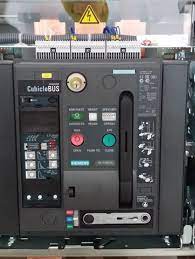Electrical circuit breakers are devices that interrupt electrical circuits normally either manually or remotely. Essentially, a circuit breaker’s main function is to interrupt a circuit under some fault conditions, such as a short circuit, an overcurrent, etc. It is commonly used to switch systems or protect them with circuit breakers.
The same purpose is achieved by relays, switches, fuses, etc. that are associated with circuit breakers.
Transformers, switch gears, motors, alternators, generators, among other parts, are often protected and controlled by circuit breakers in power systems and industries. Industries use different types of circuit breakers, which include air circuit breakers. This article is all about ACB with its working and more.
What is ACB breaker?
An air circuit breaker (ACB) protects electric circuits from overcurrent’s and short circuits in circuits that have a current greater than 800 amps to 10 000 amps. The majority of these components are used in applications that operate at low voltages of below 450 volts. Panels with distribution systems (below 450V) often contain these systems.
When operating at a given atmospheric pressure, air circuit breakers act as arc extinguishers in the air as an arc extinguishing medium. Air circuit breakers and switching gears are available in the market today that are durable, reliable, and easy to install, and require little maintenance. Circuit breakers made of oil have been replaced with circuit breakers made of air.
Read morre:What Is Fixed Automation? An Extensive Guide About Fixed Automation
What are the workings of the ACB beaker?
A free-air circuit breaker operates with its contacts in the open. They use a completely different method to control arc quenching than oil circuit-breakers. The high-voltage oil breakers are now being replaced by these devices for the interruption of low-voltage power.
The contacts on an air circuit breaker are usually divided into two pairs. During normal operation, the majority of the current is carried by copper metal contact pairs (1). The second pair of contacts are made of carbon and are called arcing contacts (2). Normally, the main contacts must be opened first before the circuit breaker can be opened. Contact between the main and arcing contacts remains even after the main contacts are opened.
As the current flows through the arcing contact, it finds a parallel low resistance path. There is a low likelihood of any arcing occurring during the main contact opening. Arcing occurs after contact is finally severed between the arcing contacts. The arc contacts are fitted with arc runners that aid in the connection.
There are a number of factors contributing to the upward movement of the arc discharge. In the arc chute, consisting of splatters, the arc enters during its upward drive.
When the air circuit breaker operates, the chute arc becomes colder, longer, and splitter, causing the arc voltage to become much higher than the system voltage and eventually extinguish.
Electromagnetic forces within the chute cause the arcs in each section to take on a helical configuration. All these helices are connected in series, so the arc is greatly extended and its resistance is greatly increased. In this case, the circuit will experience a reduction in current.
According to the idealized circuit breaker, when oscillations begin between C and L, this resistance heavily dampens them. A high-frequency oscillation cannot occur most of the time because the damping is so heavy that oscillation cannot occur, so the restriking voltage rises dead-beat to its generation peak voltage instead.
Purpose of ACB breaker
Air circuit breakers are commonly used in power plants and industrial plants for controlling electrical systems. Low voltage equipment is easy to control because they are good at controlling it. Due to their effectiveness, they are useful for protecting industrial plants, capacitors, electrical machines, and generators.
Most often, these circuit breakers are used in locations prone to fire and explosion hazards. It is possible to categorize air circuit breakers into three types. Three types of air circuit breakers exist: basic break air circuit breakers, magnetic blowout air circuit breakers, and air chute circuit breakers.
Pros of ACB breaker
- There is a reduction in maintenance requirements.
- The interrupting medium, which is chemically stale as well as inert, is cheaper and more readily available.
- An option for high-speed reclosure
- High-speed operations are provided by this machine.
- Frequent operations are suitable for them.
- It eliminates the fire hazard associated with oil circuit breakers.
Cons of ACB breaker
- Installation and maintenance of an air compressor plant are required
- When air is discharged into the open atmosphere during an air blast circuit breaker interruption, there is a lot of noise produced
- There is a current chopping problem in air blast circuit breakers
- There is a problem with voltage re-striking
What are the Applications of ACB breaker?
- It is used as power control cubicles and motor control cubicles, commonly use air circuit breakers.
- Low-voltage and low- and high-current applications are the main uses of air circuit breakers.
- Because air circuit breakers have a very short arcing time, they are best used in applications with high fire hazards.
- The use of Air Circuit Breakers is most appropriate for frequent and high-speed applications such as starting motors and protecting capacitors.
Conclusion
A low-voltage circuit is protected by an air circuit breaker, which is primarily used to turn on and off high currents. It serves as the controller of a factory, a building, as well as a ship’s standard circuit breaker. Depending on the use, numerous accessories can be attached to it.





